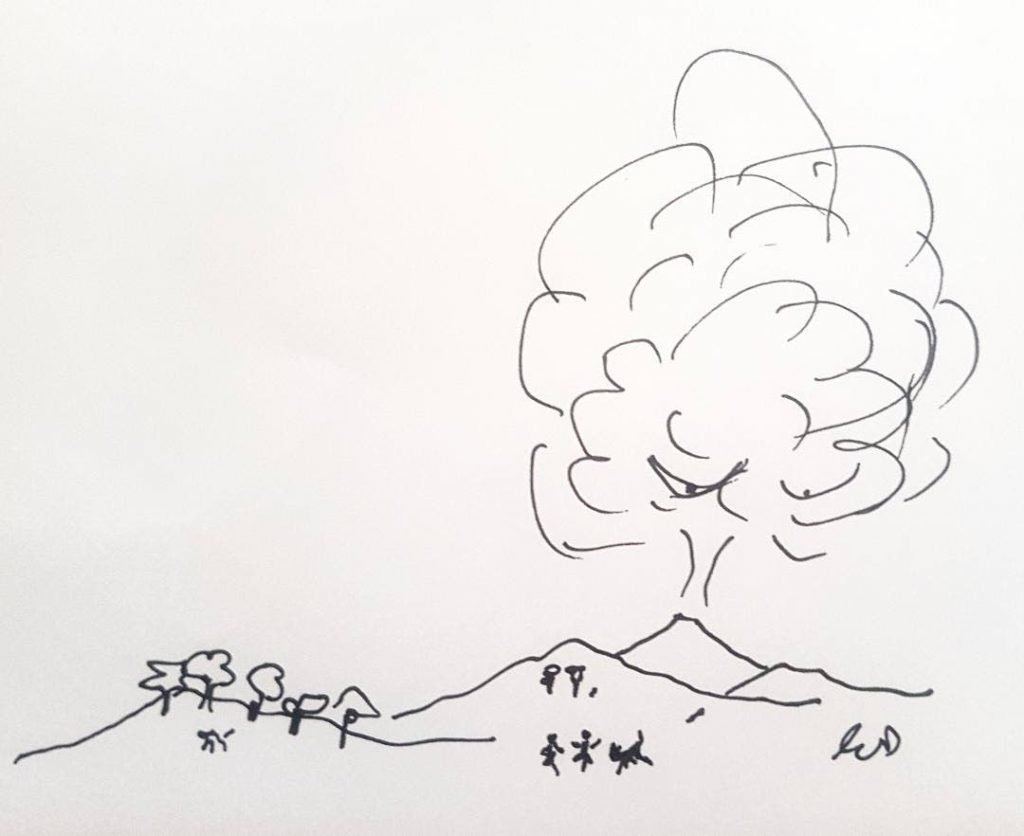The sulphur lady of St Vincent

“Being one of the two younger children in the family, I was never included in the trips that my parents and older siblings took to La Soufriere,” Aunty Hayden (Daddy’s youngest sister) recently wrote to me in an e-mail documenting her early memories of St Vincent’s volcano.
“As a child, I was always fascinated with the idea of La Soufriere: the highest mountain in our land with a beautiful lake in the middle. I understood that the air temperature was cool at the summit and that intermittent fog and clouds often blanketed the view while hikers were up there. I recall that my two older sisters wore sweaters on their trips. My view of the volcano in those days was limited to picture postcards, and they were beautiful. As a child, I used to feel proud that St Vincent had a volcano. I had no idea of its potential danger.”
Her e-mail went on to mention the so-called Soufriere flower, the blossom of the locally-dubbed Soufriere Tree (Spachea elegans) that grew on the volcanic slopes and was destroyed by natural disaster. No longer growing wild, the tree can be found in the St Vincent Botanic Gardens.
While the government website states that the tree is a purely endemic species, botanists (of which Daddy is the most renowned from St Vincent) acknowledge that the tree is native to Guyana, Venezuela and Brazil. It was reportedly introduced to St Vincent from British Guiana in 1791.
My sisters and I spent several childhood vacations in St Vincent with our parents, staying with our paternal grandparents at their hilltop family home in Montrose. Upon arrival we were always greeted by exuberant “Good morning” calls from the beloved family pet, Jerry – a St Vincent Amazon parrot (the national bird of St Vincent) whose large cage hung in the breezy verandah.
The family had acquired Jerry in 1969 as a featherless, days-old chick. In the seventies, when owning a parrot became illegal, owners were granted permission to keep them. They were banded, registered, and strict laws that ensured their well-being were put into place. When Jerry died in the late 90s, Aunty Jean had to register his death.
The original home of this parrot is the forested area around the volcano. In the wake of the dense volcanic ash and deadly pyroclastic flows of La Soufriere’s recent eruptions, has the endangered national bird gone the way of the national flower?
Daddy, Aunty Hayden and Aunty Greta now live in Trinidad, the US and Canada respectively. Aunty Jean, the only sibling still living in St Vincent (in the relatively safe southern part of the island), is the sole relative to experience "the Sulphur Lady’s" first volcanic discharge in four decades.
A day after the first eruption, while leading an early-morning online Kundalini yoga session, I instructed participants to “inhale” – a simple request often made during classes, and a generally taken-for-granted act, given that we breathe all the time, without having to think of it.
At that moment, as I inhaled, an awareness of the residents of St Vincent (both animal and human) rushed to my mind with heartbreaking impact.
Imagine inhaling thick, suffocating ash – the weight of which can cause roofs to collapse and once-proud coconut trees to slouch like grieving giants.

Humans, thankfully, can at least wear masks, flee from red zones and remain indoors in efforts to reduce ash inhalation. What about wild animals or those abandoned by red zone evacuees, tethered or left to wander?
As I write, rain has started to fall. My mind drifts again to St Vincent. There, this rainfall could quickly turn ash to a carpet of sticky sludge; a concrete-like substance plastering vegetation and the coats of animals outdoors. The natural instinct of animals to clean themselves by licking their fur or picking their feathers becomes life-threatening as the sticky, toxic residue enters their systems.
“My impressions of La Soufriere have morphed over my lifetime,” Aunty Hayden wrote in her e-mail. “First, it was a mysterious, beautiful place, where grownups hiked on holidays. Then it was an attraction for locals and visitors, the home of the national flower, and its environs the natural habitat of the St Vincent Amazon parrot. Now it is the source of my sorrow over the destruction of my beautiful homeland.”
I’m sure I join with many around the world in saying: May there be immense support and swift healing for beautiful St Vincent and all of her inhabitants (humans and animals).


Comments
"The sulphur lady of St Vincent"